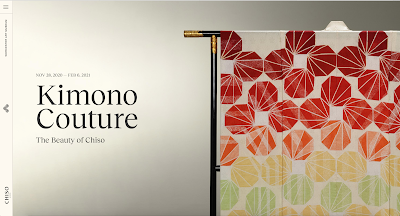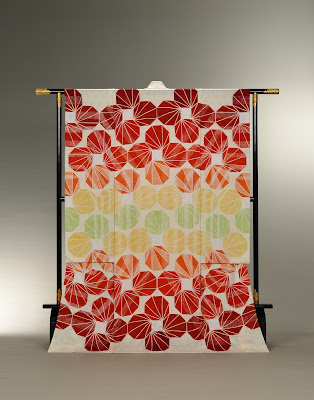Rachel Parikh, WAM's Assistant Curator of Asian and Middle Eastern Art, reveals the behind-the scenes details about our first virtual exhibition, Kimono Couture: The Beauty of Chiso, for which she was project manager.
As project manager (with very short notice), how did you approach creating this virtual exhibition, essentially shifting from a static to dynamic presentation?
I first met with Vivian Li and Christine Starkman, the co-curators of the exhibition, to discuss what concepts, ideas, and visual elements they wanted to bring to life in a virtual format. We wanted to emphasize the enduring and innovative artistry in creating a kimono at Chiso, the renowned 465-year-old, Kyoto-based kimono house. We decided that it would be best to tell this story through a variety of themes, from the materials used to decorate the kimono, to the collaborative process in its production (Chiso employs nearly 600 artisans!).
I teamed up with an amazing web engineer, Amanda Cheung, and designer, Ian Dickens, to create the exhibition. They intuitively understood what we wanted for the look and feel. Through their thoughtful and striking designs, layouts, and animations, Amanda and Ian masterfully conveyed Chiso’s core value: bi hitosuji, which translates to “nothing but beauty”.
How was this experience different from curating a physical exhibition?
Obviously, we were not directly working with the objects. While this makes certain aspects of curating a show easier, it does give rise to other challenges, especially from an engagement standpoint. In an in-person exhibition, wall labels are usually supplement to what you are seeing and experiencing, but in a virtual format, you have to lean into story-telling. Thus, we made the virtual exhibition both interactive and animated to not only guide the visitor through an experience that made sense, but to also give them an engaging way to understand and appreciate the subject matter.
 |
| Image from Kimono Couture Week 1. Each section of the exhibition concludes with a “Featured Kimono” tab for the viewer to learn more about the kimono representing that week’s theme. |
What was the biggest challenge?
This was an unprecedented venture for WAM, so we didn’t have anything to compare it to. We had to work through the learning curve, and that involved making sure everyone was on the same page. We were able to learn from the experience and create something that is beautiful, insightful, and inviting. Now, we have a set-up that we can replicate moving forward.
Additionally, because the virtual exhibition was the first of its kind for WAM, another challenge was figuring out how to contextually navigate it. Kimono Couture was intended to be an in-house exhibition. We realized early on that we cannot replace it or replicate an in-person experience, and so we had to shift our thinking and our approach for it to be successful on a virtual platform, which, for example, involved readapting elements, like the flow and content.
 |
| Image from Kimono Couture Week 3 discussing the main decorative techniques with behind-the-scenes images of the Chiso artisans at work. |
What was the thinking behind staggering the exhibition over 10 weeks?
We wanted the exhibition to be immersive for the visitor to get the most out of their experience with the material and to get to know Chiso. We thought that staggering the show over 10 weeks was a great way to achieve this. Each week, the visitor encounters a new theme through a different Chiso kimono. These bite-sized moments allow for one to really understand the material and content. We like the idea of creating a full story over time, in a sense mimicking the long, storied history of Chiso. The concept is also part of the exhibition’s overall interactive experience—it invites you to come and be part of a new theme.
One of my favorites is “Decorative Techniques", which features hotspots on a Chiso kimono that explains all the different tie-dyeing techniques used to create the garment. The staggering also provides a personalized experience—you can come visit any time and experience it how you want, whether it’s visiting every week, or waiting until all the weeks are revealed and binging it like a Netflix show.
Additionally, the 10 weeks also acts as a countdown to our in-house exhibition, The Kimono in Print: 300 Years of Japanese Design (February 6 – May 2, 2021). Kimono Couture beautifully dovetails into The Kimono in Print through our specially commissioned Chiso wedding kimono—the first kimono to ever be commissioned as art for a museum—which is featured in both exhibitions. Kimono Couture gives you an opportunity to go behind-the-scenes in its creation, while The Kimono in Print lets you see it in person. The last year certainly blurred the lines between time and space, and I think both of these shows collectively embody that through their different platforms and ways of experiencing them.
What opportunities does a virtual exhibition offer that a physical exhibition doesn’t?
There are actually quite a few. First, you really have an invaluable opportunity to look at how these kimonos are made through stunning images and details of the kimonos that might otherwise be difficult to see in person, especially when the garments are in cases. Second, the exhibition is asynchronous— you can visit anytime and from anywhere through a computer or a phone. Third, while you are not feeding off of the crowd energy you find in an in-house exhibition, you have the opportunity to interact with a virtual exhibition in a personal way and through a personalized experience.
This is a whole new venture for WAM. How will this change how we engage with our audiences in the future?
This is a major milestone for us with regard to audiences and accessibility. We can bring WAM to everyone and everyone can be part of the WAM community. It’s exciting to think of people half way around the world engaging with our exhibitions. It also really changes what a “visitor” means to us— we now have the opportunity to provide WAM as an experience in any size, shape, or form—and that just opens up so many exciting possibilities for us and for our growing community.
 |
| Image of Kimono Couture’s main page from a phone. |
To view the virtual exhibition, visit Kimono Couture: The Beauty of Chiso. New weekly installments debut each Saturday through February 6, 2021.
Kimono Couture: The Beauty of Chiso is organized by the Worcester Art Museum in partnership with Chiso, the revered 465-year-old kimono design and production house based in Kyoto, Japan. Support is provided by the Fletcher Foundation and Michie Family Curatorial Fund. Research for this project was made possible by the Japan-United States Friendship Commission and the Northeast Asia Council of the Association for Asian Studies. Additional support is provided by Emily and James Holdstein, and Sandy Hubbard and Thomas J. Logan. The exhibition is sponsored by Cornerstone Bank and Imperial Distributors, Inc.
The Kimono in Print: 300 Years of Japanese Design is generously supported by the E. Rhodes and Leona B. Carpenter Foundation. Early research for this project was made possible by the Japan Foundation and the Institute of Museum and Library Services.
—January 8, 2021









